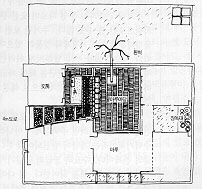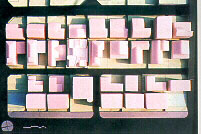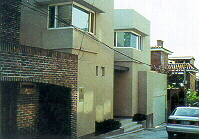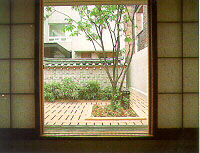| Home l ATA¼Ò°³ l »õ¼Ò½Ä l Ãßõ l E-mail l ÈÄ¿ø±¤°í l ã±â l English | |
|
|
|
Designer : Seung Hyosang Location : Nonhyon-dong, Gangnam-gu, Seoul, Korea Year of Construction : 1993 Structure : reinforced concrete + brick Floor area : 197.23 m2
|
|
The elements of space and form
¡¡ |
Yards At the center of the house there is a courtyard with a wooden floor. Several yards are placed through out the house. Each interior space of the house extends toward a yard, each with a different paving (e.g. wood, earth, gravel) according to its character.
|
| Wall and fence The house has simple, undecorated walls and fences. Most notably, it has a free-standing stone fence with traditional Korean features that serves to articulate zones of the house.
¡¡ Persimmon tree and sculpture The persimmon tree and the sculpture in the courtyard give it the character of the stage of life, and a special sense of place. ¡¡ |
Access The house is entered from the the urban housing district by a series of sequential access spaces.
¡¡ ¡¡ |
| The organization of space
¡¡ |
The house cannot be understood as a single form,
but rather as multiple spaces of diverse character. Channel-shaped composition The overall form of the house is channel-shaped. The shape and its spatial composition are similar to those of traditional Korean houses. The interaction of outdoor and indoor space The house shows the concept of the internalization of outdoor space and the interaction between outdoors and indoors.
¡¡ ¡¡ |
| The layers of space The layers of space make the house appear deeper. Level Unlike traditional Korean houses, the living room and courtyard are level, implying greater connection. There is no problem with drainage since the courtyard is paved with a wooden floor. ¡¡ ¡¡ ¡¡ |
  ¡¡ ¡¡ |
Reflections from the house...... ¡¡
¡¡
¡¡
|
What is the
role of tradition in housing? An analysis of the house leads us to reconsider the role of tradition in housing. If a house features the comfort and amenities of a traditional Korean house, while adopting modern materials and structural systems, it can be said to be a successful example of balancing Korean tradition with the realities of contemporary life. In such a way, this house allows dwelling spaces to be flexible even in a crowded urban site. This particular characteristic is also found in traditional Korean homes. Especially, Madang, the courtyard which is the central element of the traditional Korean house, is newly interpreted in this house by making the floor height of the Madang and living room even. Thus, both the practical and symbolic functions of Madang are satisfied in this house. ¡¡ ¡¡ * Source of pictures Plus, No.75 (Jul. 1993) Space, No. 310 (Aug. 1993), No.312 (Oct. 1993) Korean Architect, No. 291 (Jul. 1993), No. 292 (Aug, 1993) |
















